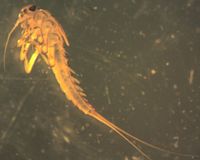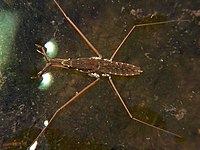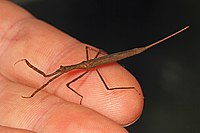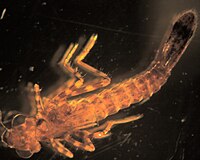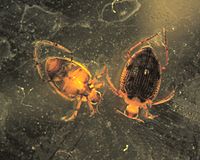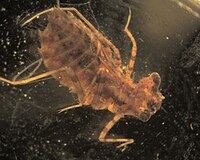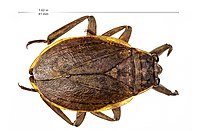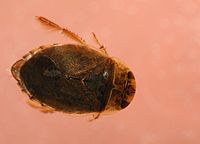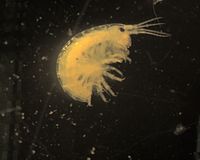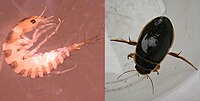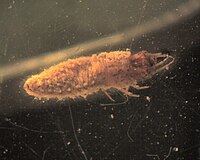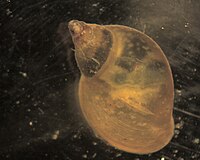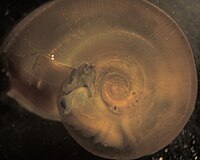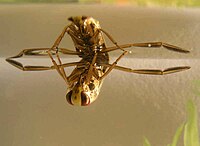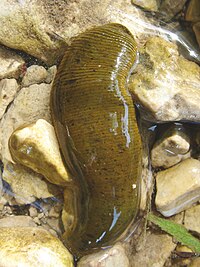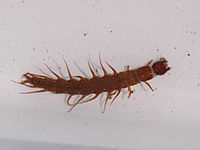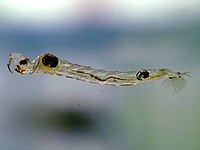Vermont EPSCoR's Streams Project; A Teacher Collaboration on WikiEducator
Openly shared content, practices, and developing resources from Vermont EPSCoR's Streams Project. Join this collaboration and make a difference!
 Shelburne Farms Pond |
|---|
|
| Basin: | Lake Champlain |
| State or Province: | Vermont |
| Country: | USA |
| Latitude: | 44.389123 |
| Longitude: | -73.253723 |
| School: | Shelburne Farms |
The following are the most common invertebrates collected from the pond between the Farm Barn and South Gate Road at Shelburne Farms. Samples were taken May 6 2017. As more macroinvertebrates are found we can add to this site. If you'd like help contact Declan McCabe at Saint Michael's College.
Baetidae
- Order
- Ephemeroptera
- Family
- Baetidae
- Common name
- Small minnow mayfly
- Tied fly
- Tiny blue-winged olive
This mayfly has either two or three cerci ("tails") and a unique head shape. Its gills are oval shaped and insert dorsally. Commonly encountered genera include
Acerpenna,
Baetis and
Pseudocloeon.
More information on the genera:
Acerpenna
Baetis
Pseudocloeon
Gerridae
- Order
- Hemiptera
- Family
- Gerridae
- Common name
- Water strider; pond skater
This insect may well be the single most recognizable macroinvertebrate we find. Although strictly a water-surface dweller, they still sometimes end up in our nets. Their 2 pairs of long legs keep them on top of the surface tension while their raptorial forelegs are poised to grab prey. For those taking benthic samples, these insects are not part of your data set.
Nepidae
- Order
- Hemiptera
- Family
- Nepidae
- Common name
- Water scorpion
These stick-like insects are frequently found submerged in pond vegetation where they are well camouflaged. Water scorpions have a long slender 'tail' that functions like a snorkel and is lacking in the smaller, surface-dwelling water measurer. Despite their fearsome name, water scorpions do not actually have a sting in their tail.
Coenagrionidae
- Order
- Odonata
- Family
- Coenagrionidae
- Common name
- narrowwinged damselflies
- Tied fly
- Polly's Green Damsel
These damselfly larvae (sub-order Zygoptera) can be distinguished from dragonfly larvae (sub-order Anisoptera) by their more slender bodies and the presence of three leaf-like gills at the end of the abdomen and The family Coenagrionidae is characterized by its distinctly shaped labium which may or may not be extended.
Images of the gills at the end of abdomen, and another here. An image of the labium, and an extended labium.
Peltodytes
- Order
- Coleoptera
- Family
- Haliplidae
- Genus
- Peltodytes
Both larvae and adults of this family of beetle can be found in ponds. The abdomen of the larvae end in 1-2 long filaments, and long filaments are also found protruding for elsewhere on its body. The adults are characterized by their hind coxae which are greatly expanded and cover the first couple abdominal segments.
Image of the hind coxae.
Libellulidae
- Order
- Odonata
- Family
- Libellulidae
- Common name
- Skimmer
These dragonfly larvae (sub-order Anisoptera) can be distinguished from damselfly larvae (sub-order Zygoptera) by their more robust bodies and an abdomen that ends in five 'spikes' as opposed to three gills. The family Libellulidae is characterized by their spoon-shaped mouthparts.They are distinguished from the other family with this trait, Cordulegastridae, by the small rounded teeth on the edges of their palpal lobes.
Images of the spoon-shaped mouthparts, and the small, rounded teeth.
Belostomatidae
- Order
- Hemiptera
- Family
- Belostomatidae
- Common name
- Giant water bug; toe biter
These spectacular insects are among the largest we collect and so the first common name is appropriate. The second common name we list is also unfortunately true; wading barefoot in a pond may confirm this. There are 2 parallel structures coming off the back end that distinguish this family from most other true bugs; these become more obvious in older individuals. Larger individuals also become more pointed at the back end. We used a photograph of a younger specimen because those are most commonly sampled and are easily confused with naucorids. Click to see an
example of a larger specimen.
Naucoridae
- Order
- Hemiptera
- Family
- Naucoridae
- Common name
- Creeping water bug
These shield-shaped insects are common in ponds. They can be distinguished from giant water bugs by the lack of paired structures on the back end. Also, creeping water bugs often have more rounded rear ends than giant water bugs. Whichever of these insects you have, handle with care to avoid a painful bite.
Hyalellidae
- Order
- Amphipoda
- Family
- Hyalellidae
The body of this scud is flattened side-to-side. It has seven pairs of walking legs and two pairs of antennae. The first pair of antennae is shorter than the second pair in members of this family.
Dytiscidae
- Order
- Coleoptera
- Family
- Dytiscidae
Adult Dytiscidae have streamlined bodies and hind-legs modified for swimming. They are characterized by the division of the first abdominal segment by the hind coxae. Don't let the paired claws and prominent 'tails' of
Dytiscus larva tempt you to think 'stonefly'; these tails are far less segmented than Plecoptera tails.The head and jaws are also unlike those of stoneflies.
Commonly found genus is Dytiscus
Images of the hind-legs, first abdominal segment, 'tails', Plecoptera tails, and the head and jaws.
Hydrophilidae
- Order
- Coleoptera
- Family
- Hydrophilidae
This beetle has one tarsal claw at the end of each leg. It is characterized by conspicuous mandibles and also several simple eyes instead of compound eyes. Click to see the
conspicuous mandibles and the
simple eyes.
Lymnaeidae
Members of the family Lymnaeidae belong in the class of Gastropoda. Members contain a single, coiled shell with a right-handed spiral. Differing from those of Planorbidae, members of Lymnaeidae have a larger opening. Respiration in these snails are through lung-like structures. Preferred habitats include those with slow streaming waters and heavy vegetation. These right handed snails are somewhat less tolerant of water pollution than our other common snails.
Images of the family Lymnaeidae and the class Gastropoda.
Planorbidae
- Order
- Basommatophora
- Family
- Planorbidae
- Common name
- Ram's horn snail
Members of the family Planorbidae belong in the class of Gastropoda. The shell of many Planorbidae is flat and dextral, or right-turned. Belonging to the largest family of aquatic pulmonates, members breathe air using a structure similar to a lung.
Images of the family Planorbidaeand class Gastropoda.
Notonectidae
- Order
- Hemiptera
- Family
- Notonectidae
- Common name
- Back swimmer
When chased by net-wielding humans, these insects will swim actively to the pond floor. If you are patient they will float back up to the surface with a pair of long oar-like legs extending out to each side. Their belly, or ventral surface, is visible from above when they are swimming; hence their common name. They break the surface with their rear ends and grab a bubble of fresh air to bring to the bottom of the pond with them. Their back surface has a distinct 'keel' and looks very boat like in shape. In many years of handling insects with large groups of students, there has been but 1 bite, delivered by a back swimmer. Handle with care!
Hirudinea
Leeches have bodies with 20 or more segments and a ventral suction disk on at least one end, though sometimes on both ends. They are segmented worms (Phylum Annelida) in the Class Hirudinea. Most of the leeches we sample come from ponds and lakes but they are also commonly found in streams.
Image of the ventral suction disk.
Corydalidae
- Order
- Megaloptera
- Family
- Corydalidae
- Common name
- Dobsonfly; Hellgrammite
Members of the family
Corydalidae share some superficial commonalities with Trichoptera, but on careful inspection one can see the
two pairs of anal claws that help place it in the order Megaloptera. The size of mature larvae is impressive; specimens from some genera exceed 8 cm in length. The abdominal segments have ribbon-like gills on the lateral portions. The mouth has mandibles that are serrated and used for biting prey. They can be confused with the more slender
whirligig beetle larvae; whirligig larvae also have
simpler jaws.
Nigronia is the genus we most frequently encounter.
Chaoboridae
- Order
- Diptera
- Family
- Chaoboridae
- Common name
- Phantom midge
- Tied fly
- Griffith's Gnat
These fly larvae are translucent with a tinge of straw-color. They are hang horizontally in the water column using air sacks near the front and rear ends of their long bodies. They are easily overlooked but are well worth a closer look if a microscope is available.
Phryganeidae
- Order
- Trichoptera
- Family
- Phryganeidae
- Common name
- Giant case maker caddisfly
These are among the largest caddisflies we collect. Their plant-material cases are straight and very slightly tapering from end to end. Unlike most caddisflies, these larvae will often leave their cases if handled. They tend to be a bright green but are easily overlooked when camouflaged in their cases. We find them in ponds and lakes.

